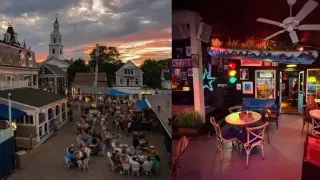February 28, 2023
Unusual Duo: Capp Street and Headlands Paired Art Installations
READ TIME: 5 MIN.
Although miles apart geographically, two conceptual art exhibits bridge the work of pioneering designers and artists. In the Mission, the David Ireland House on Capp Street is where the late artist's home has been converted into an archive and ongoing art installation.
Across the Golden Gate Bridge in Sausalito, the Headlands Center for the Arts has installed a reinvented version of a bee-themed installation by Mark Thompson. For the Headland Center's 40th anniversary, Ireland, who was one of the co-founders of the Arts Center, is being honored in both venues in works by Ann Hamilton.
To understand how insects, the military, and even accordions and dirt clods combine in thematic representation with these unusual art projects, we need to go back in time.
First, the house at 500 Capp Street, built in 1886, had long been an accordion shop before the late Ireland (1930-2009) bought it in 1975. After moving his studio to a nearby apartment, Ireland, a 1974 graduate of the San Francisco Art Institute, bought and then later turned the Capp Street house into an art exhibit of unusual materials, including stacks of wood, phone books, paint cans, and even honey jars. Ireland also dug out the basement and saved some of the concrete and dirt materials from the excavation.
Today, that basement is the home of temperature-controlled archives of Ireland's materials while the ground floor and upstairs host amusing minimal installations of objects strategically placed for a sense of curious symmetry, including one lone accordion set in a front room. The space hosts artist residencies and guest installations of other unusual objects.
A Bridge Not too Far
Over in the scenic Headlands, in 1986, Ireland, with artist Mark Thompson and several collaborators, transformed and opened a cluster of former military buildings to artists. The campus, which was renamed Headlands Center for the Arts in 1989, amplified and extended the kind of conceptual site-specific art that Ireland developed at 500 Capp Street.
Through the past four decades, numerous artists have created work in multiple genres, including writers, painters and choreographers, during paid residencies at the facility. Along with the changing installations, the building itself has a number of artistic permanent aspects.
A commonality between the Capp Street and Headlands spaces are the stunning textured walls stripped down, scraped, and coated in a beautiful saffron-yellow color, then coated on top of the paint with a polyurethane sealant.
In the East Wing of the Headlands Center, a series of rounded benches and bleachers, designed by Ireland, welcome audiences for music performances and artist talks. Numerous signs from the building's military days are now hung on the walls as artifacts. Even the toilets have artistically-installed walls. And in the spacious dining hall, amid an assortment of deliberately mismatched chairs, delicious food is served to patrons and guests.
The new installation in the gym on the west side of the main building is currently inhabited by Mark Thompson's "Semaphore." At first entrance, it's a bit confusing because there seems to be nothing in the room. But the masked windows offer a waxy hive quality, and the humming buzz of audio is from a 1976 film made by Thompson documenting his daring experimental artworks involving himself immersed by live bees. Projected on one wall are merely Thompson's eyes with bees fluttering around his face.
There's definitely a spooky element to the empty gymnasium humming with the sound of insects. The installation references Thompson's earlier works in which the audience, safely behind a mesh screen, was able to witness his performances with the herd of bees (Sorry; no live bees this time). Meanwhile, back at the Capp Street space, a few jars of decaying honey saved by Ireland serve as a throwback to Thompson's earlier performance works.
In both spaces, visual artist Ann Hamilton, an Ohio native and sculpture instructor, has recreated images of Ireland's concrete and ovoid-shaped "torpedoes" into large-scale prints that hang on the walls and are recreated in a sort of zine for guests to take home.
Hamilton's connection to the Capp Street project goes back to 1989 where she installed a most unusual work, "privation and excesses," made up of $7,500 worth of pennies with portions covered in a coating of honey. Once again, the bees and honey reference repeats itself in the new exhibits.
If all this is a bit mind-boggling, one simply has to enjoy the two disparate venues for their uniqueness. Ireland's Capp Street facility is cozy and offers a kind of fun house quality.
Thompson's spacious installation takes on a looming ominous quality in its very emptiness as the sound fills the space. Bridging the two, Hamilton's torpedo prints at both spaces expand Ireland's sculptural objects into their own sense of mystery.
While it's best to see both spaces at some point, each of them can be enjoyed on their own.
David Ireland House
Ann Hamilton's "here, there, then, now," a mixed media homage to Ireland's work, as well as Ireland's installations. One-hour guided tours Fridays 2pm & 4pm. Self-guided tour Saturdays 12 pm-5pm. 500 Capp St. (The space has an elevator, but is not fully wheelchair accessible.) www.500cappstreet.org
Headlands Center for the Arts
40th anniversary exhibits include 'Process + Place' and Mark Thompson's 'Semaphore.' Sunday–Thursday, 12pm–5pm. (First floor is accessible; upper floor only by stairs.) 944 Simmonds Road, Sausalito. www.headlands.org
Help keep the Bay Area Reporter going in these tough times. To support local, independent, LGBTQ journalism, consider becoming a BAR member.






